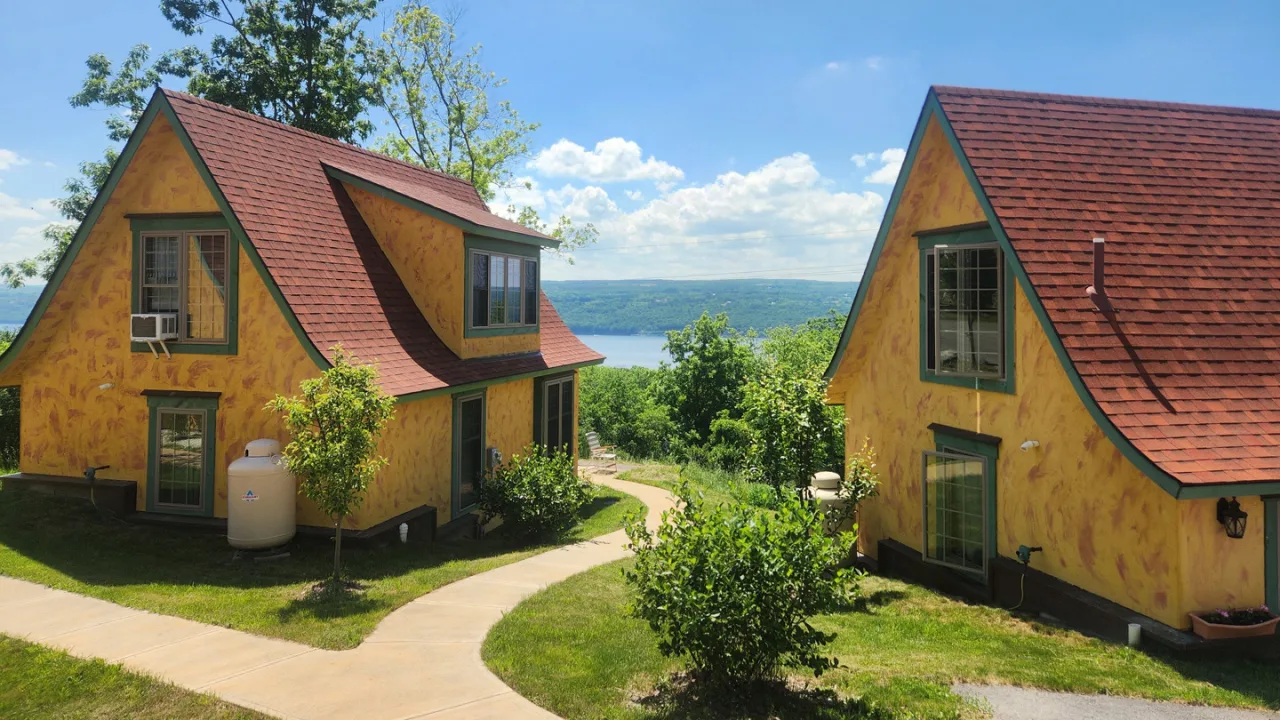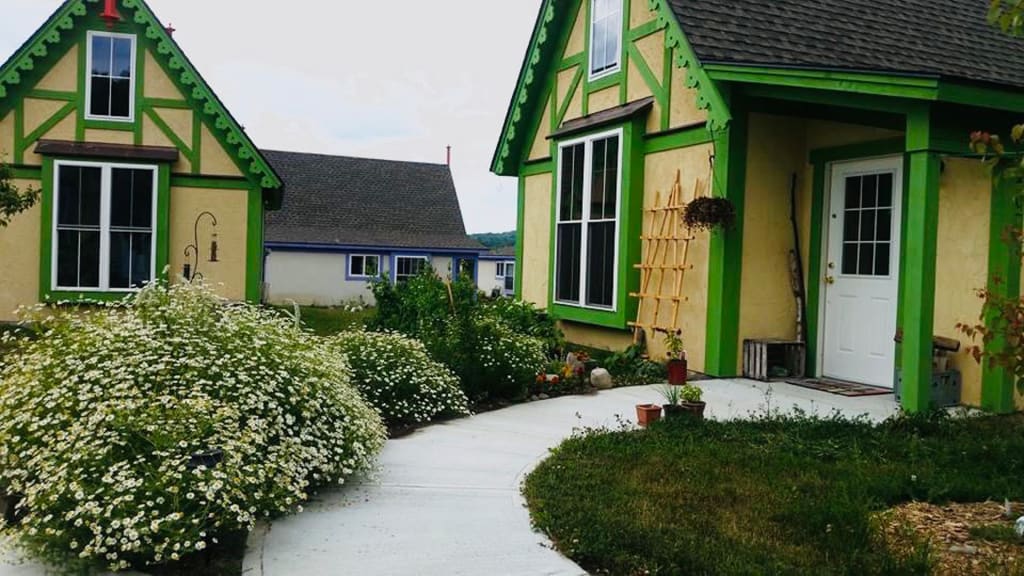Can these tiny house villages bring new life to small towns?
On Main Street in the village of Freeville, New York, on a 2.8-acre lot where a dilapidated single-family house once stood, there are now a dozen tiny storybook-like cottages surrounded by the property’s pine trees. The development, completed last year, is helping bring new life to the village. It’s one example of what’s possible when towns don’t have overly restrictive zoning. It’s charming. The design encourages neighbors to know one other. And it offers housing for far more people on the same amount of land. The project is the third tiny house village in the region from a local developer, Bruno Schickel. His career started as a typical general contractor—he built and renovated single-family homes. But in the late 1990s, while reading a children’s book to his daughters, he was inspired by an illustration of a Gothic cottage in Maine. “I said, ‘You know, I gotta design something that looks like this,’” he says. “And so that’s what I set out to do.” View this post on Instagram A post shared by Boiceville Cottages (@boiceville_) 140 fairy-tale cottages on 40 acres Schickel owned a large property in a rural area nearby that had been part of a farm. One winter 29 years ago, when regular work slowed down, he asked his crew to build three rental cottages on the site, each with the same gingerbread design as the house in the children’s book. People loved them, so he built another three the next winter. The cottages range in size from 540 square feet to 1,100 square feet, but even the smallest units have a second-story loft for a bedroom and feel relatively spacious. There are now 140 of the homes, called Boiceville Cottages, on the 40-acre site. “The more I built, the better people liked them,” he says. “It was an interesting dynamic, because originally people were drawn to the fairy-tale cottage. And then people started being drawn to the community that was created.” [Photo: Bruno Schickel/courtesy Boiceville Cottages] A sense of community When I visited on a recent spring day, a group of neighbors was sitting at a picnic table next to the community’s meeting house while children played on a playground. While I was talking to a retired woman, teenagers playing basketball called out a greeting to her. Everyone seemed to know one another. “I lived in a suburb of Chicago for 45 years,” one resident, Christine Uliassi, told me. “My husband and I raised our kids there. But I know my neighbors here much better than I knew my neighbors there.” The cottages in the development are clustered in groups of three, each carefully angled so that when someone looks out their own window, there’s still a sense of privacy. But they’re so close together that people continually run into each other. At the meeting house, neighbors pick up their mail, use the on-site gym, and gather for book clubs and other events. The road between the cottages winds around curves, so people drive slowly, and it feels safe to walk. Despite the rural location, there’s also a bus stop at the property, so it’s technically possible to live there without a car. The development doesn’t have the density of a large apartment complex. But the specific layout—and the bucolic country setting, which draws people outside—makes it more likely that neighbors become close. [Photo: Bruno Schickel/courtesy Boiceville Cottages] ‘Zoning chokes off innovation’ In many places, it would be impossible to build. “The one reason why I ended up building there was because there was no zoning in Caroline [the rural town where the site is located],” says Schickel. “I am a guy who thinks zoning, by design, just chokes off innovation, creativity. It creates uniformity. If you go to existing cities or towns or villages around the country and you say, ‘Oh, look at this, this is great,’ I can almost guarantee you their zoning would not allow that to be built today.” It also wouldn’t be possible in Caroline now. Last year, after a bitter fight, the town passed a zoning law that required large lots for any new home. Longtime rural residents opposed the law; wealthier transplants to the area tended to support it. “People said, ‘We love Boiceville. We want to make sure Boiceville can be built.’ But the fact is that they don’t,” Schickel says. “The result will be that they’ve preserved it for large suburban housing.” In Freeville, a zoning ordinance existed, but was flexible enough that it allowed for the conversion of the single-family lot. Neighbors were happy to see the former rundown house replaced, Schickel says, even if they were initially taken aback to learn that they’d suddenly be living next to 12 tiny houses. (The Freeville houses, in a departure from the original gingerbread design, are inspired by old railway stations and Freeville’s rail history.) In a third location nearby, where Schickel built 60 tiny cottages on a hillside overlooking a lake, the community passed a zoning law after the project happe

On Main Street in the village of Freeville, New York, on a 2.8-acre lot where a dilapidated single-family house once stood, there are now a dozen tiny storybook-like cottages surrounded by the property’s pine trees.
The development, completed last year, is helping bring new life to the village. It’s one example of what’s possible when towns don’t have overly restrictive zoning. It’s charming. The design encourages neighbors to know one other. And it offers housing for far more people on the same amount of land.
The project is the third tiny house village in the region from a local developer, Bruno Schickel. His career started as a typical general contractor—he built and renovated single-family homes. But in the late 1990s, while reading a children’s book to his daughters, he was inspired by an illustration of a Gothic cottage in Maine. “I said, ‘You know, I gotta design something that looks like this,’” he says. “And so that’s what I set out to do.”
140 fairy-tale cottages on 40 acres
Schickel owned a large property in a rural area nearby that had been part of a farm. One winter 29 years ago, when regular work slowed down, he asked his crew to build three rental cottages on the site, each with the same gingerbread design as the house in the children’s book. People loved them, so he built another three the next winter. The cottages range in size from 540 square feet to 1,100 square feet, but even the smallest units have a second-story loft for a bedroom and feel relatively spacious. There are now 140 of the homes, called Boiceville Cottages, on the 40-acre site.
“The more I built, the better people liked them,” he says. “It was an interesting dynamic, because originally people were drawn to the fairy-tale cottage. And then people started being drawn to the community that was created.”

A sense of community
When I visited on a recent spring day, a group of neighbors was sitting at a picnic table next to the community’s meeting house while children played on a playground. While I was talking to a retired woman, teenagers playing basketball called out a greeting to her. Everyone seemed to know one another.
“I lived in a suburb of Chicago for 45 years,” one resident, Christine Uliassi, told me. “My husband and I raised our kids there. But I know my neighbors here much better than I knew my neighbors there.”
The cottages in the development are clustered in groups of three, each carefully angled so that when someone looks out their own window, there’s still a sense of privacy. But they’re so close together that people continually run into each other. At the meeting house, neighbors pick up their mail, use the on-site gym, and gather for book clubs and other events.
The road between the cottages winds around curves, so people drive slowly, and it feels safe to walk. Despite the rural location, there’s also a bus stop at the property, so it’s technically possible to live there without a car. The development doesn’t have the density of a large apartment complex. But the specific layout—and the bucolic country setting, which draws people outside—makes it more likely that neighbors become close.

‘Zoning chokes off innovation’
In many places, it would be impossible to build. “The one reason why I ended up building there was because there was no zoning in Caroline [the rural town where the site is located],” says Schickel. “I am a guy who thinks zoning, by design, just chokes off innovation, creativity. It creates uniformity. If you go to existing cities or towns or villages around the country and you say, ‘Oh, look at this, this is great,’ I can almost guarantee you their zoning would not allow that to be built today.”
It also wouldn’t be possible in Caroline now. Last year, after a bitter fight, the town passed a zoning law that required large lots for any new home. Longtime rural residents opposed the law; wealthier transplants to the area tended to support it. “People said, ‘We love Boiceville. We want to make sure Boiceville can be built.’ But the fact is that they don’t,” Schickel says. “The result will be that they’ve preserved it for large suburban housing.”
In Freeville, a zoning ordinance existed, but was flexible enough that it allowed for the conversion of the single-family lot. Neighbors were happy to see the former rundown house replaced, Schickel says, even if they were initially taken aback to learn that they’d suddenly be living next to 12 tiny houses. (The Freeville houses, in a departure from the original gingerbread design, are inspired by old railway stations and Freeville’s rail history.)
In a third location nearby, where Schickel built 60 tiny cottages on a hillside overlooking a lake, the community passed a zoning law after the project happened. “There’s a complete discrimination against rentals,” he says. “And there’s a discrimination against small [houses].”

Tiny house villages can help struggling communities—and the housing crisis
In the rural areas where Schickel built, the neighborhoods can help struggling economies. Caroline would have lost population without Boiceville Cottages; a popular local store, Brookton’s Market, probably couldn’t survive without it. And the approach can add more housing as rents continue to rise. (To be fair, the cuteness of the cottages means that Schickel can charge a premium for rent, but as in any housing market, adding supply helps moderate prices.)
It’s a model that Schickel says others want to replicate in other parts of the country. He continually fields calls from potential developers and city officials. “I just heard from a senior planner on Long Island,” he says. “He called me up and said, ‘How can we do something like that down here?’ I said, ‘I can tell you right now, your biggest problem is zoning.’”



































































































![Building A Digital PR Strategy: 10 Essential Steps for Beginners [With Examples]](https://buzzsumo.com/wp-content/uploads/2023/09/Building-A-Digital-PR-Strategy-10-Essential-Steps-for-Beginners-With-Examples-bblog-masthead.jpg)





![How One Brand Solved the Marketing Attribution Puzzle [Video]](https://contentmarketinginstitute.com/wp-content/uploads/2025/03/marketing-attribution-model-600x338.png?#)































